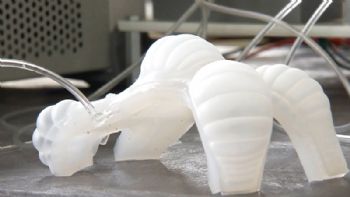
At NASA’s Langley Research Center in Hampton (nasa.gov), Virginia, interns Chuck Sullivan and Jack Fitzpatrick are developing a series of soft robot actuators.
Mr Sullivan said: “What we’re investigating is the viability of soft robotics in space exploration and assembly.
“While the word ‘robot’ conjures images of metal arms and gears, soft robotic actuators are bio-inspired, looking at the way nature works to create new robot movements.
"By being constructed from highly flexible materials, soft robots can move in ways similar to living organisms, allowing new ranges of motion that traditional robots simply can’t have.
“Space applications of these actuators can expand the role of robots in exploration and assembly.”
Mr Fitzpatrick said: “When you actuate a soft robot, it changes how you use the material properties.
“For example, a piece of rubber can go from being flat to the shape of a finger, changing the inanimate material into something else.”
The current process being developed by Sullivan and Fitzpatrick is to 3-D print a mould and then pour in a flexible substance like silicone.
The actuators incorporate chambers (air bladders) that expand and compress based on the amount of air in them, allowing them to flex and relax, just like a human muscle.
From their investigations, Sullivan and Fitzpatrick hope to help see what other applications soft robotics could have in the future.
To do that, they need to create actuator designs and test them in a series of experiments; they have determined four ‘lines of inquiry’ about the properties of actuators — mobility, joining, levelling and shaping.
Based on these properties, Sullivan and Fitzpatrick plan to establish the potential uses and limitations of soft robotics in space exploration and assembly.
They say mobility is looking into how actuators can move, such as across the lunar surface, while joining is vital to exploring how actuators could interlock and link together, possibly to make a temporary shelter.
Levelling is looking at how actuators can create or adjust a surface, such as filling in the space under a lunar habitat module, while strengthening looks at adding strength to a material by pressurising it (using the air bladders).
Mr Sullivan said: “We see these four things as the crux of the problem. Once we can accomplish those in individual unit tests, we would like to figure out ways to combine them.”